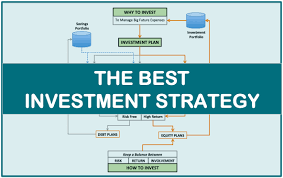Did you know that only 32% of Americans are on track with their retirement savings? This startling statistic underscores the critical importance of developing effective investment strategies throughout your life.
As we journey through different stages of life, our financial needs and goals evolve, demanding a dynamic approach to wealth building. In this comprehensive guide, we’ll explore the best investment strategies tailored to each life stage, empowering you to make informed decisions and secure your financial future.
Skale Money Key Takeaways
- Investment strategies should be tailored to your current life stage and future goals
- Starting early with retirement savings can significantly impact long-term wealth
- Diversification is crucial for managing risk across all life stages
- Regular portfolio rebalancing helps maintain an appropriate risk level as you age
- Technology is reshaping investment landscapes, offering new tools for wealth management
Table of Contents
Understanding Life Stages and Investment Goals
As we progress through life, our financial priorities shift, necessitating adjustments to our investment strategies. Understanding these life stages and their corresponding financial characteristics is crucial for developing effective investment plans.
Key life stages and their financial characteristics:
- Young adulthood (20s): Building foundations, managing debt
- Early career (30s): Balancing growth and increasing responsibilities
- Mid-career (40s): Accelerating wealth accumulation
- Pre-retirement (50s): Focusing on preservation and final push for savings
- Retirement (60s and beyond): Generating income and preserving capital
| Life Stage | Typical Financial Goals |
| Young Adulthood | Build emergency fund, start retirement savings, pay off student loans |
| Early Career | Increase retirement contributions, save for home purchase, start family planning |
| Mid-Career | Maximize retirement savings, invest in children’s education, consider wealth transfer |
| Pre-Retirement | Boost retirement savings, reduce portfolio risk, plan for healthcare costs |
| Retirement | Generate sustainable income, manage required minimum distributions, estate planning |
Best Investment Strategy for Young Adults (20s)
Your 20s are a critical time for laying the foundation of your financial future. The power of compound interest makes this decade incredibly valuable for long-term wealth building.
Key investment priorities for this stage:
- Start retirement savings early
- Build an emergency fund
- Manage and pay down debt
- Invest in personal development and career growth
Strategy 1: Maximizing Retirement Accounts
One of the best investment strategies for young adults is to maximize contributions to tax-advantaged retirement accounts such as 401(k)s and IRAs. If your employer offers a 401(k) match, aim to contribute at least enough to receive the full match – it’s essentially free money.
Strategy 2: Building an Emergency Fund
While not traditionally considered an “investment,” an emergency fund is crucial for financial stability. Aim to save 3-6 months of living expenses in a high-yield savings account.
Advice: Balancing Student Loan Repayment and Investing
- Prioritize paying off high-interest debt (typically above 6-7% interest)
- Consider income-driven repayment plans for federal student loans
- Once high-interest debt is managed, split extra funds between debt repayment and investing
- Take advantage of any available loan forgiveness programs
Best Investment Strategy for Early Career Professionals (30s)
In your 30s, you’re likely experiencing career growth while also facing increased financial responsibilities. This stage requires a balanced approach to investing.
Financial challenges and opportunities in this stage:
- Higher income potential
- Increased expenses (housing, family planning)
- Need for more comprehensive insurance coverage
- Opportunity for aggressive investment growth
Strategy 3: Diversifying with Index Funds and ETFs
One of the best investment strategies for this life stage is to focus on diversification through low-cost index funds and ETFs. These offer broad market exposure and help manage risk.
Strategy 4: Considering Real Estate Investments
Real estate can be an excellent way to diversify your portfolio and build long-term wealth. Consider options like buying a primary residence, investing in rental properties, or exploring REITs (Real Estate Investment Trusts).
| Investment Vehicle | Pros | Cons |
| Index Funds | Low fees, broad diversification | Limited control over specific investments |
| ETFs | Tradeable throughout the day, often tax-efficient | May incur trading fees |
| Individual Stocks | Potential for high returns, voting rights | Higher risk, requires more research |
| Real Estate | Tangible asset, potential for passive income | Less liquid, requires more capital |
Best Investment Strategy for Mid-Career Individuals (40s)
Your 40s are prime years for accelerating wealth accumulation. With potentially higher income and a more established career, you have the opportunity to supercharge your investments.
Key financial considerations for this life stage:
- Maximizing peak earning years
- Balancing retirement savings with other goals (e.g., children’s education)
- Increasing focus on wealth protection alongside growth
Strategy 5: Increasing Contributions to Tax-Advantaged Accounts
One of the best investment strategies at this stage is to maximize contributions to all available tax-advantaged accounts. This includes maxing out 401(k)s, IRAs, and potentially Health Savings Accounts (HSAs).
Strategy 6: Exploring Alternative Investments
To further diversify your portfolio, consider exploring alternative investments such as REITs, peer-to-peer lending, or even small business investments.
Advice: Balancing Children’s Education Savings and Retirement Planning
- Prioritize retirement savings over education savings
- Consider 529 plans for tax-advantaged education savings
- Explore scholarships, grants, and work-study programs for children’s education
- Remember: You can borrow for education, but not for retirement
Best Investment Strategy for Pre-Retirees (50s)
As you approach retirement, your investment strategy should shift towards preserving wealth while still allowing for some growth.
Critical financial actions to take during this stage:
- Catch-up contributions to retirement accounts
- Reassess risk tolerance and adjust portfolio accordingly
- Develop a retirement income strategy
- Consider long-term care insurance
Strategy 7: Rebalancing Portfolio for Reduced Risk
One of the best investment strategies for pre-retirees is to gradually shift your portfolio towards a more conservative allocation. This typically means increasing the proportion of bonds and decreasing stocks.
| Asset Allocation Model | Stocks | Bonds | Cash |
| Aggressive | 80% | 15% | 5% |
| Moderate | 60% | 35% | 5% |
| Conservative | 40% | 50% | 10% |
Adapting Investment Strategies for Retirees (60s and beyond)
In retirement, your investment strategy shifts focus from accumulation to preservation and income generation.
Key financial goals for retirees:
- Generating sustainable retirement income
- Managing required minimum distributions (RMDs)
- Estate planning and wealth transfer
- Protecting assets against inflation
Advice: Strategies for Generating Retirement Income
- Implement a systematic withdrawal strategy (e.g., the 4% rule)
- Consider a bucket strategy to balance short-term needs with long-term growth
- Explore annuities for guaranteed income
- Optimize Social Security claiming strategy
| Income-Generating Investment | Pros | Cons |
| Dividend Stocks | Potential for growth and income | Market volatility risk |
| Bonds | Steady income stream | Lower returns, interest rate risk |
| Annuities | Guaranteed income for life | Less flexibility, potential high fees |
| Real Estate Investment Trusts (REITs) | High dividend yields, diversification | Sensitive to interest rates, potential liquidity issues |
The Role of Technology in Modern Investment Strategies
Technology is revolutionizing how we approach investing, offering new tools and platforms that make implementing the best investment strategies more accessible than ever.
Key technological advancements in personal finance:
- Robo-advisors for automated portfolio management
- Mobile investing apps for easy trading and monitoring
- Artificial Intelligence for market analysis and predictions
- Blockchain and cryptocurrencies as new asset classes
Advice: Choosing the Right Robo-Advisor or Investment App
- Compare fees and minimum investment requirements
- Assess the range of available investment options
- Look for features like automatic rebalancing and tax-loss harvesting
- Consider the level of human support available if needed
- Read user reviews and check the platform’s security measures
Common Pitfalls to Avoid in Every Life Stage
While the best investment strategies vary by life stage, there are some universal errors to avoid:
- Failing to start investing early
- Not diversifying your portfolio
- Trying to time the market
- Neglecting to rebalance regularly
- Letting emotions drive investment decisions
| Life Stage | Common Pitfall | How to Overcome |
| Young Adult | Neglecting retirement savings | Automate contributions to retirement accounts |
| Early Career | Lifestyle inflation | Create and stick to a budget that prioritizes savings |
| Mid-Career | Inadequate diversification | Regularly review and adjust your asset allocation |
| Pre-Retirement | Taking on too much risk | Gradually shift to a more conservative portfolio |
| Retirement | Withdrawing too much too soon | Implement a sustainable withdrawal strategy |
Conclusion
Mastering the best investment strategies for each life stage is key to unlocking long-term wealth and financial security. From the growth-focused approach of your 20s to the income-generation needs of retirement, adapting your strategy as you progress through life is crucial.
Remember, the most effective investment plan is one that aligns with your current circumstances and future goals.
As you’ve learned, the best investment strategies evolve with you:
- Maximize retirement accounts early (20s)
- Build an emergency fund (20s-30s)
- Diversify with index funds and ETFs (30s-40s)
- Consider real estate investments (30s-40s)
- Increase contributions to tax-advantaged accounts (40s-50s)
- Explore alternative investments (40s-50s)
- Rebalance portfolio for reduced risk (50s and beyond)
Take the time to assess your current investment strategy. Are you implementing the best investment strategies for your life stage? If not, now is the perfect time to make adjustments and set yourself on the path to long-term financial success.
FAQ Section
How often should I review my investment strategy?
It’s recommended to review your investment strategy at least annually or when you experience significant life changes.
Is it ever too late to start investing?
While starting early is ideal, it’s never too late to begin investing. The best investment strategies can be adapted to your current life stage and goals.
Should I prioritize paying off debt or investing?
Generally, prioritize paying off high-interest debt (e.g., credit cards) before investing, but consider balancing low-interest debt repayment with investing.
How much should I be saving for retirement?
Aim to save 15-20% of your income for retirement, including any employer matches. Adjust this based on your age and current savings.
Are robo-advisors a good option for implementing investment strategies?
Robo-advisors can be an excellent, low-cost option for many investors, especially those just starting out or preferring a hands-off approach.
How do I know if my investment strategy is too risky?
If market fluctuations cause you significant stress or if your portfolio’s volatility doesn’t align with your financial goals and time horizon, your strategy may be too risky.
Should I include cryptocurrency in my investment strategy?
Cryptocurrency can be considered as part of a diversified portfolio, but due to its high volatility, it should generally make up only a small portion of your overall investments.
Author: Cosmas Mwirigi
Cosmas Mwirigi is an established freelance writer with over five years of experience and the founder of Skalemoney.com. Cosmas Mwirigi has been published on PV-Magazine, Slidebean, Bridge Global, Casinos.com, Gambling.com, and Reverbico among many other websites.
Cosmas Mwirigi is an expert writer in iGaming, B2B, SaaS, Finance, digital marketing and Solar renewable energy. To contact him for his services, connect with him on his LinkedIn
![]()




